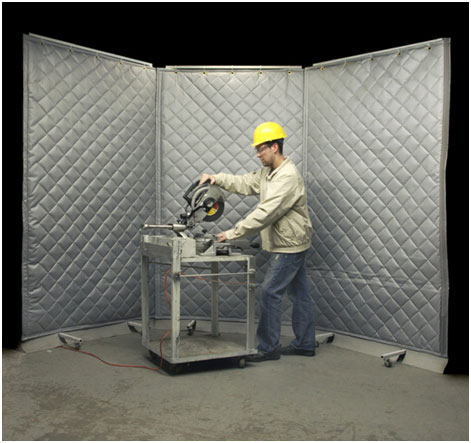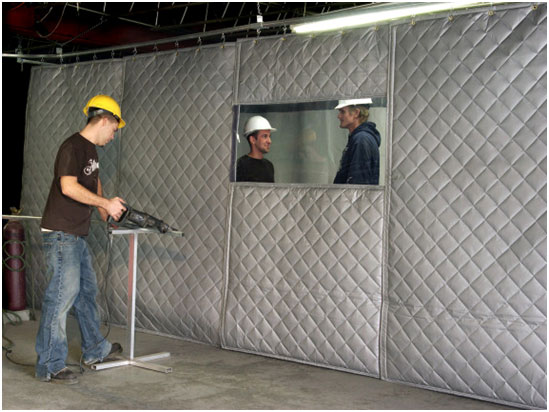American Made, Iron Clad Protected - Discover the Industries Best Warranty.

Blog
Control Decibels With Sound Shield Curtains

The work environment of a manufacturing facility affects the productivity and efficiency of its workers. Production lines make sure safety standards are met while keeping work areas clean and operational.
Few consider the productivity benefits of noise-cancelation or noise reduction curtains. Reducing noise in the workplace improves the personal, organizational and social environment of the space.
Health risks are also associated with prolonged exposure to high noise volumes.

The Negative Effects of Workplace Noise
The adverse effects of sound have been well-documented. The effects are long-lasting and impact workers on physical, emotional and mental levels.
The most common effect is noise-induced hearing loss. Roughly one-third of all workers suffer from some form of hearing loss at work, which is caused by extensive exposure to a certain noise.
High-pitched hearing decreases first, then scales backward until all pitches are effected. The problems caused can be healed over time, but in some cases the damage can become permanent. Daily exposure can put workers at risk for tinnitus, which is a constant humming that buzzes in workers’ ears.
Extensive noise pollution can affect unborn children in pregnant women, effecting blood pressure and provoking insomnia. The fetus might have increased sensitivity to noise. Personal protective equipment (PPE) like earplugs cannot mitigate noise pollution damage to the fetus.
Noise pollution increases the chance for workplace accidents, as well. Loud noises make communication more difficult, and increases the risk that a signal will be misunderstood.
Workers will have a harder time looking out for danger, and sudden noises can distract employees.
Excessive sound causes stress. Anxiety builds, and even without hearing loss, an employee can develop other physical signs of strain, like headaches and a loss to cognitive functions.
Stress level varies based on a number of factors, like regularity, the volume and pitch of the noise, how difficult the workers’ tasks are to complete, how much concentration is required, and occupation.
Regularly-occurring noises can either be a blessing or a curse; some employees find it easier to block out noises that become a part of the environment, while others may anticipate the sound and build anxiety.
Additionally, the UCLA Health Impact Assessment has found that mental disorders like depression, anxiety and anger can all develop or be exacerbated by regular noise pollution. Frustration may arise from being too distracted to complete work, speech interferences, changes to blood pressure, or loss of sleep.
The Uses of Sound Shield Curtains
From corporate headquarters to manufacturing sites, there are a variety of uses for sound-dampening curtains.
Curtains and dividers can turn a conference room into several meeting areas. These barriers are great at reducing sound between two speakers talking just a few yards apart, cutting out fan noise, or for hanging over windows to block out light and external racket.
Curtains may also be used to block out dust and noise from construction sites. They can be handy for large sub-contractors performing extensive interior work in an office building, or outside and close to the street.
As movable barriers, sound shield curtains are great for press, fan and compressor enclosures, especially for buildings where printing/manufacturing and office space is shared. They are also good for compactor noise control, plenum barriers and as “removable” doors.

There are a number of applications that sound shield curtains and customized flexible wall curtains can be used for. Contact Steel Guard today for more information about product solutions that will work for you.

Recent Posts
- 7 Common Mistakes to Avoid When Setting Up Machine Guarding Fences
- Industrial Curtain Walls: 6 Reasons Why Manufacturing Facilities Must Have Them
- Industrial Soundproof Curtains: How to Decide Between Floor-Mounted and Ceiling-Mounted Curtains
- How to Transform a Noisy Open-Plan Office with Acoustic Baffles
- A Guide to Choosing the Best Concrete Blanket for Construction Projects
- Porch Curtains: 8 Amazing Reasons to Install These Curtains in Your Home
- Chemical Splash Curtains and Their Applications in Different Industries
- Outdoor Sound Curtains for Farms and Animals
- Construction Sound Barriers: Why Every Construction Site Should Have These?
- Industrial Blackout Curtains and Their Applications in Different Settings
Categories
- Accordion Fold Curtains
- Acoustic Baffles
- Agri-Shield Curtains
- Auto Body Shop Curtains
- Bio Plastics
- Industrial Divider Curtains
- Industrial Safety Products
- Insulated Curtain Walls
- Machine Guard Safety Fencing
- Mesh Curtain Screens
- Outdoor Curtains
- PVC Strip Curtains
- Soundproof Noise Blocking Curtains
- Spray Paint Booth Curtains
- Tarps
- Thermal Curtains & Covers
- Uncategorized
- Warehouse Dividers
- Welding Blankets
- Welding Curtains
- Welding Screens



